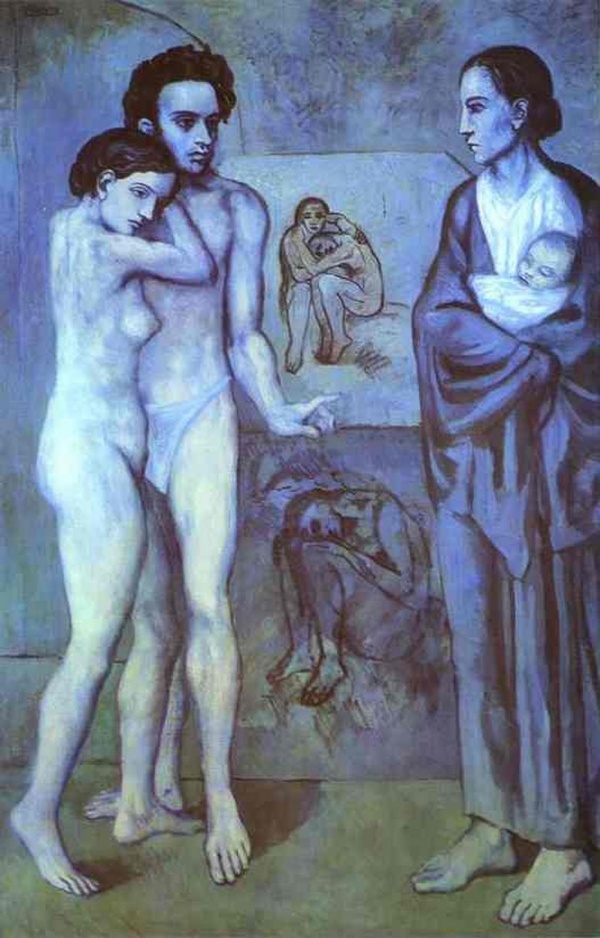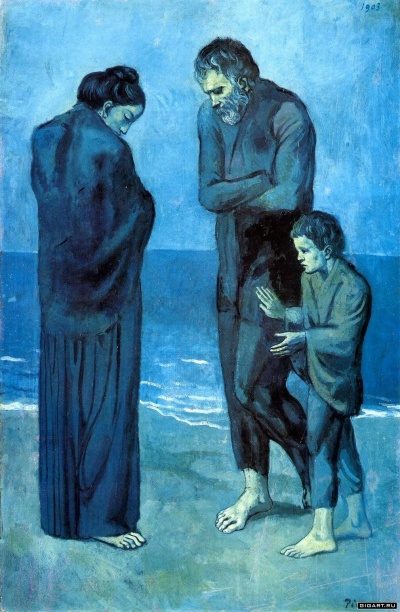Difference between revisions of "Reconstruction:La Vie (Picasso)"
Thaumasnot (talk | contribs) |
Thaumasnot (talk | contribs) |
||
| Line 3: | Line 3: | ||
[[File:Picasso, La Vie 1903.jpg|center|600px]] | [[File:Picasso, La Vie 1903.jpg|center|600px]] | ||
Two couples are {{def|opposed|opposition}} as verticalities: the naked adult couple on the left, and the mother and child on the right. The {{ref|opposition}} is marked by {{def|convexities}} that follow the contour of figures painted in {{def|light}} colors: the naked bodies (the couple on the left and the paintings in the middle) and the {{ref|convex}} {{def|unity}} of the mother cradling the child in contrast to the mother’s non-{{ref|light}} clothing. | |||
[[File:Lavie-convex.png|center|frame|{{ | [[File:Lavie-convex.png|center|frame|{{ref|Convexities}}]] | ||
Horizontal {{def|conjunctions|conjunction}} are defined by horizontal bands supported by the canvases in the background: (1) the woman on the left and the child, and (2) the man and the woman on the right, whose {{ref|conjunction}} is enforced by the perfect alignment of the heads: | |||
[[File:Lavie-bandes.png|center|frame|{{ | [[File:Lavie-bandes.png|center|frame|{{ref|Conjunctions}}]] | ||
Then the sight-line of the woman on the right, linking to the man’s left wrist and going up along the hand at an angle, forms a {{def|trajectory}} that {{def|crosses|cross}} the orthogonalities of {{ref|opposition}} and {{ref|conjunction}} by underlining {{ref|unity}} as opposed to just the child. | |||
[[File:Lavie-extern.png|center|frame| | [[File:Lavie-extern.png|center|frame|{{ref|Trajectory}}]] | ||
==Correlated painting: ''Des pauvres au bord de la mer''== | |||
== | |||
[[File:Des-pauvres-au-bord-de-la-mer.jpg|center|400px]] | [[File:Des-pauvres-au-bord-de-la-mer.jpg|center|400px]] | ||
This painting uses a form of {{ref|trajectory}} in the diagonal from the woman’s forearm down the child’s right hand, the falling edge of his upper garment, and the man’s leg at an angle. The {{ref|trajectory}} groups all three figures by {{ref|crossing|cross}} their vertical {{ref|opposition}} and the horizontal {{ref|conjunction}} (underlined by the man’s crossed arms) between the woman and the man. The {{ref|trajectory}} projects into the parallel vector made by the faces of the man and the child as they both nod the same way, forming a {{ref|light}} {{ref|unity}} that contrasts the non-{{ref|light}} clothing. | |||
[[Category:Painting]] | [[Category:Painting]] | ||
[[Category:Pablo Picasso]] | [[Category:Pablo Picasso]] | ||
Revision as of 23:20, 9 December 2021
Two couples are as verticalities: the naked adult couple on the left, and the mother and child on the right. The is marked by that follow the contour of figures painted in colors: the naked bodies (the couple on the left and the paintings in the middle) and the of the mother cradling the child in contrast to the mother’s non- clothing.
Horizontal are defined by horizontal bands supported by the canvases in the background: (1) the woman on the left and the child, and (2) the man and the woman on the right, whose is enforced by the perfect alignment of the heads:
Then the sight-line of the woman on the right, linking to the man’s left wrist and going up along the hand at an angle, forms a that the orthogonalities of and by underlining as opposed to just the child.
This painting uses a form of in the diagonal from the woman’s forearm down the child’s right hand, the falling edge of his upper garment, and the man’s leg at an angle. The groups all three figures by their vertical and the horizontal (underlined by the man’s crossed arms) between the woman and the man. The projects into the parallel vector made by the faces of the man and the child as they both nod the same way, forming a that contrasts the non- clothing.




